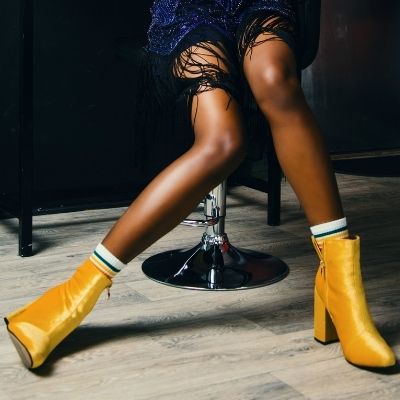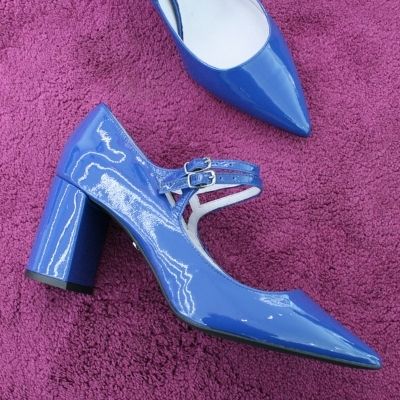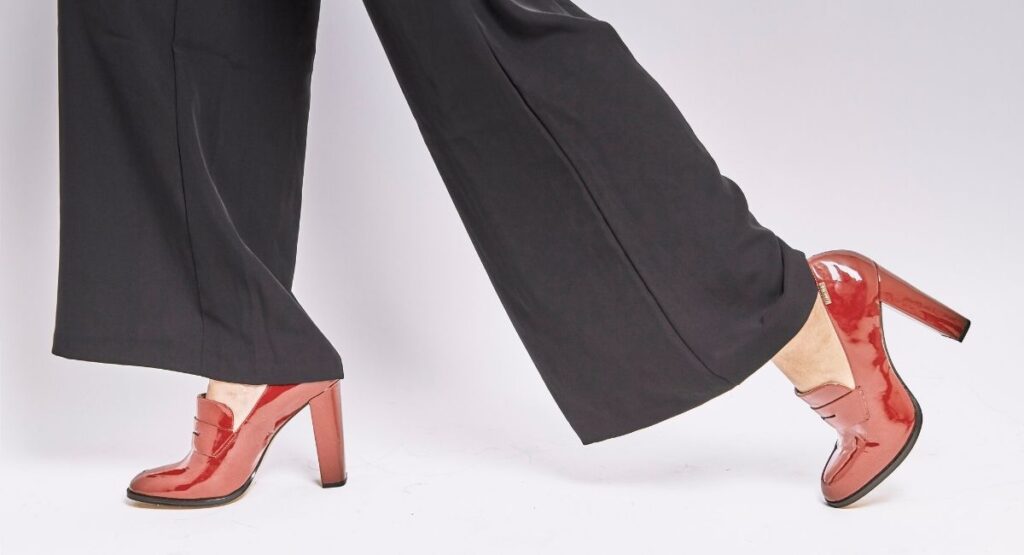Off to the Grand National Festival? Wearing high heels can be daunting if you’re faced with spending a whole day (and night too) on your feet.
Whether you are standing in the bar or following the Circuit Ritual, there’s not much time to sit down at the races so your best bet is to get your footwear right so it doesn’t blight your day.
Sarah Johnson, professional podiatrist and former Fox Hunters Chase jockey, offers the following advice:


SHOE SHOPPING
1. The best thing you can do when buying high heeled shoes, is to look for shoes with a deep sole on the front part of the shoe – a bit like platform shoes. The deep sole under your toes and ball of your foot will give more cushioning and also more warmth.
2. The high heeled shoe should be able to stand up on its own easily (i.e. balance) and not tip over if you poke it! Also, if you can find a heel that is wider when you look at it from the back of the shoe, that will provide more stability. It doesn’t have to be a fully block heel, it can be narrow when you look from the side, but width under your heel will prevent your feet from wobbling side to side.
3. Wedge heels are ideal – they provide more support under the arch of your foot, so if you suffer joint pain or get a sore back for example, these are the ones for you. If you suffer back pain then opt for a slightly lower heel.

4. For any high heeled shoes (including wedges) then the more straps the shoe has to hold it on to your foot, the better. This will again provide more stability – wobbling or movement of your feet inside the shoe is your enemy (see below).
5. If your shoe has a closed toe, or a strap across the toes, check that the positioning of the crossing point is not directly over your toe joints (where your foot bends up from your toes). If it is higher up your foot this will be much more comfortable and not irritate foot problems such as bunions. Also check it is not too tight, so it won’t dig in when you walk.
6. Very flat shoes, such as ballerina styles, may seem ideal but make sure they fit! If they are too loose they can cause just as much damage as high heels: loose shoes cause you to claw your toes to hold the shoes on as you walk, and initially this can cause a rub across the tops of the toes, but longer term this can cause the foot arches to collapse, and/or bunion issues.
7. Medium block heels provide stability with some height.
8. Shoes with a low heel (but not totally flat) are a good option but again, only if they fit well.

The key with any shoes is to make sure they fit well. You will know if this is the case because they will feel fine straight away – no rubs or places of pressure, they should feel comfortable right from the start.
However, shoes are made in a relatively limited choice of sizes and shapes whereas feet come in many shapes and sizes and are also affected by the way you walk. So, NEVER buy shoes that are too big or too loose (see above). But if you have shoes that are a little too tight there are some steps you can take to improve them:

DO YOUR FEET A FAVOUR
Shoe stretchers (Robinson’s Shoes, from £10) are great. Leave them in your shoes when you are not wearing them, and you will be surprised at the difference they can make. Some shoe shops also offer a shoe stretching service. A home-made equivalent is to stuff your shoes tightly with paper, or if you need to allow for bunions, use golf balls as well. Even better, leave your shoes in a humid environment while they are being stretched – hanging in a cotton bag inside the top of your shower for example!
Wear your new shoes around the house for a few days before you wear them to the races – leather will naturally stretch a little as it is worn, and you can expound this process by wearing thick socks too.
If you’re worried about small rubs, or if you like to wear shoes without socks/tights, then a great anti-blister preventative is Akileine’s Sports NOK cream (£7.25 from SimplyFeet). You can use Vaseline, but this is better! Another option is shoe liners – sort of mini-socks, that fit your foot inside the shoe but don’t show outside the shoe.
If you do feel a blister coming on, get a Compeed or blister plaster on it straight away, and it should be okay. For shoes that have a particular rubbing point – e.g. the back of the heel – then apply a plaster before it turns into a blister at all. Compeed Blister Plasters, from £4.25 from Boots.
Many people turn to insoles or inserts to try and cushion their feet better in the hope of avoiding pain. If you follow all the points above, hopefully you won’t need extra additions to your (perfectly fitting) shoe, but for a long day/night on those heels there are some tips that can help you come away less sore from the sheer physicality of wearing high heels:

INSIDER’S TIPS
Insolia Heels gel insoles help people whose toe joints ache when/after wearing high heels. They are clinically proven to redistribute your weight to take pressure off the toe joints and roll it back more onto your heel. This is particularly effective in heels that are 3” high or more. In my opinion, everyone wearing high heels should have these insoles! They are less useful with lower than 3” heels, but worth a try if you suffer from toe joint pain – however, you would be better off with wedge heeled shoes in that instance.
Scholl ‘Party Feet’ (£5.50 from Boots) or similar gel pads that sit under the front half of your foot are better if you have joint pain and wear lower than 3” heels, as they add more cushioning to your shoe. If your pain is from pressure (the foot being forced into the front of the shoe by the height of the heel) then this is not the solution for you – Insolia would work better.
If walking around on high heels for too long is impossible for you, take a spare pair of flat shoes to change into. Fold-up flats fit into a handbag and come in many fun and sparkly colours so just because they’re short on heels doesn’t prevent them from being long on style! Just remember to bring a fold-up bag too, to carry your high heels around in.

AVOIDING LONG TERM ISSUES
Wearing high heels all of the time, non-stop, can cause your tendons and calf muscles to shorten over time. Sometimes older ladies come to me and when they take their heels off they fall over backwards because their heels can no longer touch the ground when their foot is flat. If you can’t keep your heel down on the ground you will get more foot problems at the front of your foot such as bunions, collapsed arches etc. The way to avoid all of this is to make sure you do spend time in flat shoes as well – perhaps give your legs/heels a stretch at lunchtimes or coffee breaks. Take your slippers to work for padding around in when you’re not required to be formal!

There is a myth associated with pointy-toed shoes that they are the main cause of bunions. It is true that high heeled shoes cause toes to be pushed into the front of the shoe and therefore the big toe has no choice but to follow the shape of the shoe – and if it is always a pointy shoe then this might over many years cause a bunion. But that is not the most likely cause (see below).
In fact, bunions are often hereditary – it is more likely your inherited bone structure will cause the bunion over time. So even if you wear flat, wide-toed shoes, you could still develop a bunion if your parents or grandparents suffered from them too. If someone in your family has a bunion, a podiatrist can help you to reduce your chances of developing one too, with specially tailored insoles and exercises to help alleviate the mechanical issues caused by your bone structure.
Other causes of bunions can be issues such as stiff ankles – if your ankle does not flex properly when you walk, your foot is more likely to angle outwards (walking with your toes turned out) and this sideways roll over your big toe joint can eventually cause a bunion. Watch yourself in a mirror or ask a friend to tell you if you walk with your toes pointing outwards – you may need some tailored orthotic insoles to help correct your gait and some ankle exercises to loosen things up! Compeed Bunion Plasters £7.29 from Boots.
You may know the rhyme ‘For want of a shoe, the foot was lost; For want of a foot the horse was lost; For want of a horse the battle was lost…” The same applies to you: foot issues caused by ill-fitting shoes or hereditary issues can affect your balance and gait, and over time this can cause knee, hip and back problems.
The tips in this article will hopefully help you enjoy your day at the races in more comfort, but if your shoes or feet are constantly uncomfortable – no matter what style or height of heel – it is well worth seeking professional advice, as, something as simple as a tailored orthotic insole could help your skeletal health for many years to come!
Sarah Johnson (M.Ch.S. D.Pod.M) is a Podiatry Biomechanics specialist. She can be contacted at Forest Hill Practice, Forest Road, Tarporley, Cheshire CW6 0HX. Tel. 01829 731360.

Karen can usually be found glued to her computer or at the stables. Having edited several national magazines she co-founded Eclipse Magazine in 2008 after realising that many of her friends were nervous about going racing due to lack of information – what to wear, how to bet etc.
She absolutely loves her job (how many people can say that?!) and is truly grateful to all supporters of and contributors to Eclipse Magazine.
If you are reading this she would like to say THANK YOU! (And please spread the word about Eclipse…!!)




